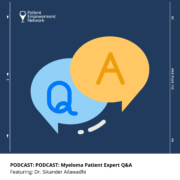Advances in Myeloma Molecular Testing
Advances in Myeloma Molecular Testing from Patient Empowerment Network on Vimeo.
What is molecular testing, and how does it impact myeloma care? Dr. Abdullah Khan from the Ohio State University Comprehensive Cancer Center – The James discusses the specific markers found in cytogenetic analysis that determine a patient’s risk and may impact treatment choices.
Dr. Abdullah Khan is a hematologist specializing in multiple myeloma and plasma cell disorders at the Ohio State University Comprehensive Cancer Center – The James. Dr. Khan is also an assistant professor in the Division of Hematology at The Ohio State University. Learn more about Dr. Khan.
Related Programs:

What Tests Are Essential Before Choosing a Myeloma Treatment Approach? |

|

|
Transcript:
Katherine:
Have there been advances in molecular testing for myeloma patients?
Dr. Khan:
Molecular testing is a broad term and can indicate checking genes, proteins, and other molecules. Even let’s say speaking outside of the world of myeloma, molecular testing can be used to determine in individuals if they have a high chance of developing cancers or other diseases.
It can be done to confirm so cancer diagnoses using the tissue biopsy specimens. It can also be used to help plan treatment, find out how well the treatment is working, provide prognosis information, and other information. In the world of myeloma, there are – in the world of myeloma, there are researchers looking at all of these molecular changes that can happen with disease.
Katherine:
So, how do the results of these tests affect treatment?
Dr. Khan:
There’s a particular cytogenetic change called translocation 11;14 that’s found in maybe a quarter of all patients with newly diagnosed myeloma, and it predicts a high likelihood of responding to a new drug called venetoclax.
In the clinical trial of venetoclax, when it was given to all patients with multiple myeloma, there was actually higher mortality in patients when given venetoclax in combination with bortezomib and dexamethasone. And this is despite a higher response rate by adding the venetoclax.
The thought process was maybe those patients were not doing well because of higher chances of serious infections. But when they took the data and they looked at that subgroup of patients with the translocation 11;14, there was no such concern in that subgroup. So, in this case of having translocation 11;14, it actually giving you a new treatment option based on the findings of the molecular testing.
We participate in a national clinical trial called MyDRUG, and that’s looking at other molecular changes to see if a more targeted treatment when added to the backbone of myeloma therapies translates to better outcomes.
Another recent development in molecular testing is diagnostic testing for minimal residual disease, and that’s from the bone marrow in patients with multiple myeloma.
The most commonly used test in clinical trials is the clonoSEQ test; it’s an FDA-cleared diagnostic test. The way it works it looks for specific DNA sequences on the receptors of the cancer cells. So, each cancer cell has like a genetic barcode.
Using the liquid part of the marrow, we can look for those cells that harbor that genetic barcode.
And the test is so sensitive, we can find one in a million cells in a patient’s bone marrow aspirate. So, it’s a very sensitive test, but it is not yet approved for making treatment decisions. One way we can use it though is for prognostic information. So, a patient attaining minimal residual disease-negative status or MRD-negativity, probably will do better than someone who has MRD-positive disease.
And there’s an emerging concept called sustained MRD negativity. So, let’s take an example of someone getting MRD testing at one year and two years after their stem cell transplant. The patient who is MRD-negative at both the one-year and two-year marks will likely do better than the one who is MRD-negative at one year but turns positive at the two-year mark.
So, these are some of the new developments in molecular testing in multiple myeloma.










